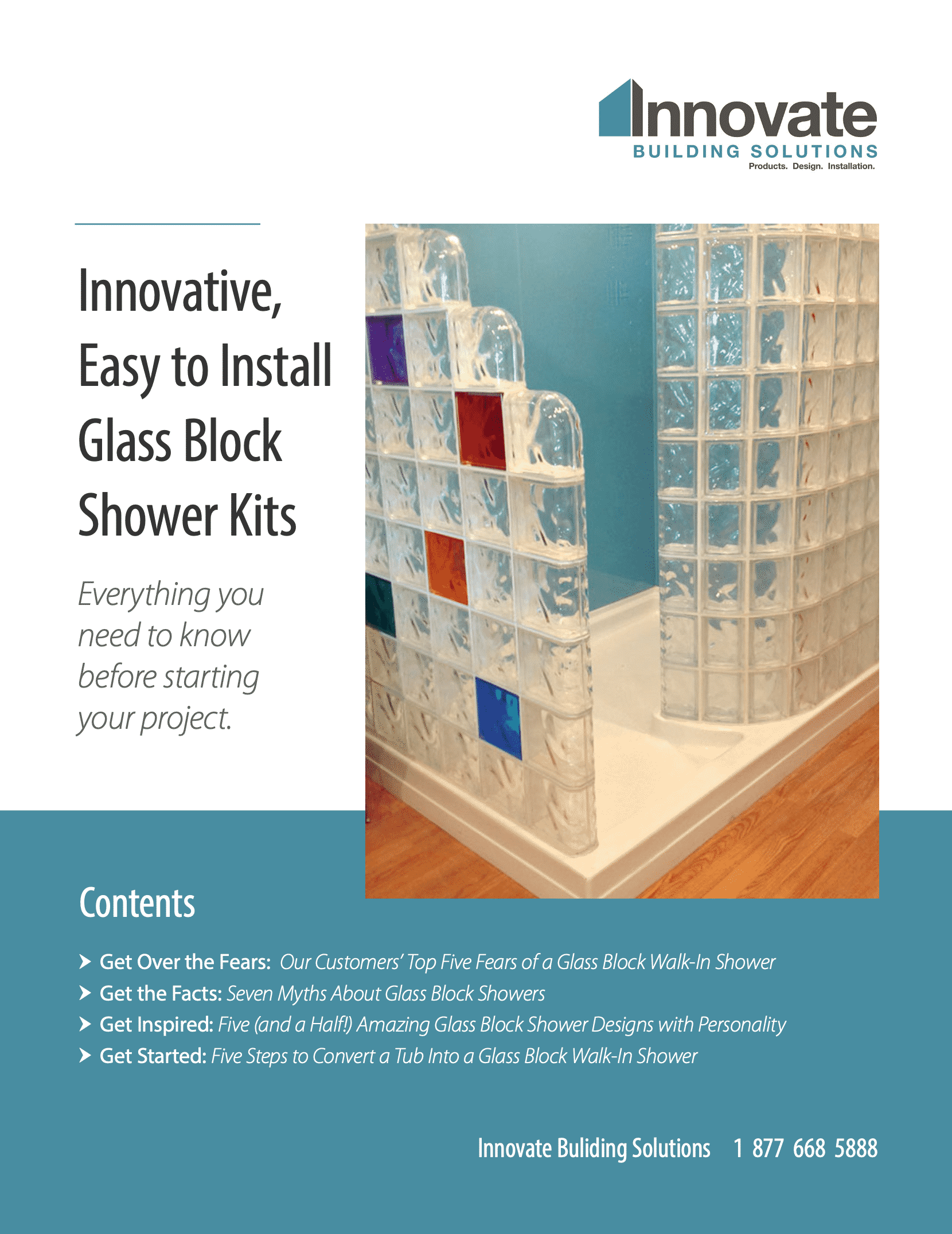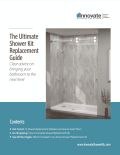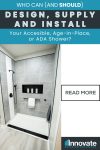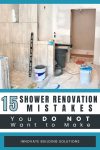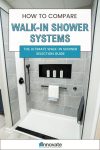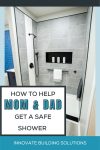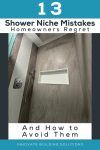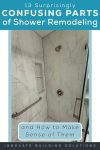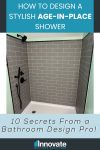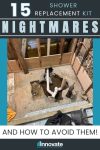Do you Need an ADA, Accessible, or Age In Place Shower? And Does it Have to Look Ugly?
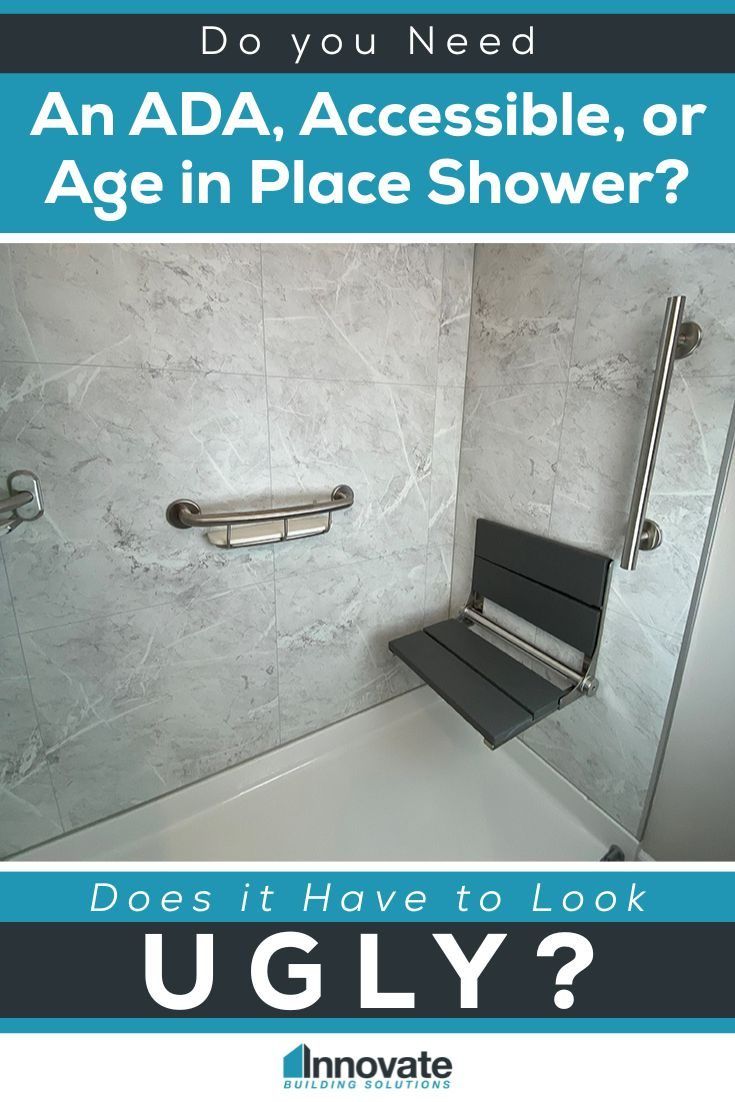
I can’t believe I’m going to tell you this. Although I’ve written over 1,000 bathroom remodeling articles, and spoken to contractors who specialize in the accessible, age in place and ADA (Americans with Disability Act) shower market, and earned the CAPS (Certified Aging in Place) designation, I still felt a little fuzzy differentiating ADA, accessible, and age in place showers. Either I just ‘ain’t very bright’ (a definite possibility), and/or this stuff is confusing.
So, I decided to do what I’ve been meaning to do for years, write an article focused on this topic.
I know many people dread needing an ADA, accessible, or age in place shower in the first place. They’re worried it’ll look institutional and ugly. I’ll tell you (and show you) fortunately this DOES NOT have to be the case. And also, I’ll do my best to make sure this subject isn’t too doggone dry.
It’s important to know when you need each of these showers, and what are the requirements of each to make it function flawlessly now AND in the future, since you don’t remodel a shower as frequently as you change your underwear (hopefully). And for many people they’d also like a shower which’ll look good, and NOT kill your ability to resell the home. And if your shower looks like ‘Grandma lives here’ or it resembles a hospital shower, be prepared for it to sit on the market a long time when it comes time to sell.
To accomplish these objectives this article will be split into 5 sections:
- Section 1 – What’s the definition of an ADA, accessible and age in place shower? And when do you know which of these three types of showers you need?
- Section 2 – What are the smallest size(s) and curb/threshold requirements for an ADA, accessible, and age in place shower?
- Section 3 – Can I convert a standard 60” tub into an ADA, accessible or age in place shower?
- Section 4 – What products would be best for the shower floor, shower walls, grab bars, seats, and controls for ADA, accessible or age in place showers? Where can I find choices which ARE NOT ugly or institutional?
- Section 5 – Who can I consult with, or contract to build my ADA, accessible, or age in place shower?
Let’s dig into Section 1.
Section 1) What is an ADA, accessible, or age in place shower? When do you know which of these three types of showers you need?
An ADA shower is one which meets the design standards of the Americans with Disability Act.
It allows people using it to shower safely (and in some cases independently) even if they have mobility challenges. This can include those using wheelchairs.
It’s important to understand an ADA shower is ONLY required for public or commercial buildings (or group homes). It IS NOT REQUIRED for private single family homes.

An accessible shower is designed for a specific owner(s) who often has disabilities and/or is a wheelchair user.
Safety takes ‘center stage’ in an accessible shower. They’re used in private residences and DO NOT NEED to follow ADA guidelines! Even though accessible showers put ‘safety first,’ they DO NOT need to look ugly (more about this in section 4). Types of accessible showers include roll in showers, barrier free showers, or showers with low profile pans. You’ll often see grab bars, handheld showers, and seating in an accessible shower.
An age in place shower is one which is ‘future focused’ and primarily used in residential homes.
Once again there is no ‘legal requirements’ (like ADA showers). These showers are designed to help owners stay in their homes longer (and minimize, or eliminate, the costs of assisted living facilities). And 2024 studies put the average cost of assisted living facilities between $4,500 and $5,900. And that’ll cover the cost of a bathroom remodel in a short period of time.
In age in place showers, you’ll find a mix of low profile shower pans, one level wet rooms, grab bars, non-slip flooring, handheld showers, and fold down seats.
Bottom line, you need an ADA shower if it’s being used in a public building. If not, FUGGITABOUT ADA (as a New Yorker might say), it doesn’t apply to you.
For accessible and age in place showers – the line between them is blurrier – because both are used in private homes. However, the biggest difference is an accessible shower is designed around a specific person(s) needs right now – vs. an age in place shower is designed to make the home livable – even if a health or mobility condition presents itself in the future.
Section 2) What are the smallest size(s) and curb/threshold requirements for an ADA, accessible, and age in place shower?
ADA shower size requirements
ADA showers have specific requirements. For ‘transfer-type’ ADA shower (which means someone is transferring from a wheelchair to a seat inside the shower) the smallest size is 36” x 36” minimum ON THE INSIDE OF THE SHOWER!
The ‘inside of the shower requirement’ is important to understand because many people think they can buy a standard 36” x 36” shower pan for a transfer ADA shower. However, this IS NOT the case because after you add the wall surrounds on the sides of a 36” x 36” pan – the inside space will measure about 34” wide (and won’t meet the requirements).

There is also the roll in ADA shower. It requires a minimum inside of 60” x 30”. Once again in a standard residential home if you’re removing a common-sized 60” tub – once you add wall surrounds on the sides the finished inside width will be closer to 58.” Once again it WILL NOT meet ADA requirements. This is the reason you’ll find ADA roll in fiberglass shower pans made 63” wide (to allow for the wall surrounds, yet still provide the 60” inside space to make it simpler to rotate a wheelchair).
The threshold has to be beveled and ½” or less.
Also, ADA showers require a 48” x 36” open area to transfer outside the shower as well.

And yes, I know this isn’t fun and sexy stuff to talk about. However, the fun stuff is coming in section 4. Hang in there with me!
Accessible and age in place shower size requirements
There aren’t specific size requirements for accessible showers, but they’ll often be barrier free or roll in showers – without a curb (A.K.A. a threshold). However, you’ll also find low profile shower pans used in accessible showers.
On the other hand, age in place showers are not usually designed as ‘roll in showers.’ Most age in place showers have low profile curbs like you’ll see below.
Another stylish – and forward thinking – way to create an age in place shower is with a ‘one level wet room’ where the bathroom and shower floors (basically) are at the same level (although the drain is still the lowest spot). A wet room installation requires the shower AND bathroom floors be waterproofed. Wet rooms are cool – but will be more expensive (generally) than barrier free or ramped shower pans.
Section 3) Can I convert a standard 60” tub into an ADA, accessible, or age in place shower?
The short answer is yes and no.
There are many small bathrooms with tub alcoves which are 60” x 30” or 60” x 32” (after the wall surrounds have been removed and you’re down to the studs).
And if you’re in a public facility which requires an ADA roll in shower– the only way you’re going to achieve it (because the ADA roll in shower requires a FINISHED inside dimension after the wall surrounds are installed of 60”) would be IF you can make the alcove wider (possibly by removing a closet or wall on one side). In addition, ADA requires a 48” x 36” space to transfer outside the shower.
However, if you’re looking to remodel a residential home and want an accessible or age in place shower where your tub is today so you don’t need to worry about a loved one getting hurt climbing over the edge of the tub, this IS NOT a problem, is done all the time, and doesn’t require removing walls. Check out the cool tub to shower conversion below.

Section 4) What products would be best for the shower floor, shower walls, grab bars, seats, and controls for an ADA, accessible, or age in place shower? Where can I find choices which ARE NOT ugly or institutional?
How to choose the shower floor or shower pan for an ADA, accessible or age in place shower.
If you’re selecting an ADA shower floor there are no specific product recommendations, but the flooring must be slip resistant, and thresholds must be a maximum of ½” high and beveled (allowing for wheelchair entry). In addition, the floor must be sloped (typically ¼” per foot). And it’s best if the flooring is simple to clean.
If you want a cost-effective ADA shower a ramped fiberglass or acrylic shower pan is most common.

If you’ve got a larger budget – and want a fashion-forward ADA shower –a one level tile wet room, or solid surface ramped shower pan are smart choices.

On the other hand, with an accessible shower, the most important determination will be if the shower floor (or shower pan) will work for the specific person(s) it’s designed for. Do they need a ramped or roll in shower? Would a low profile pan (like you’ll see below) be good enough.
When it comes to age in place showers, low profile pans are most common (and usually most cost-effective). The key is to think long-term about what the needs/abilities of the people using the shower will be. Also make sure the floor is slip resistant, the threshold isn’t too high, and you don’t choose a material which’ll look ugly/institutional and will make it hard to sell the property. And for ‘bonus points’ choose a low profile pan with a separate ‘ramp kit’ you can place next to the pan, so you’re even covered if a wheelchair is required at a later date.
The best looking choices are often one level wet rooms (and if you go this way choose large format tiles to make cleaning easier) and/or low profile stone shower pans. These systems are sourced through specialty shower retailers and NOT in home centers.
And if you want to learn more about the best shower floor – or shower pan to use with an ADA, accessible, or age in place shower watch the video below:
How to choose shower wall surrounds for an ADA, accessible or age in place shower.
If there’s one place you can add style, pizzazz, and fun (and yes, even safe showers can be fun), it’d be in the shower wall surrounds. And while the shower floor (or shower pan) is (literally) ‘foundational’ to a shower’s success, it’s not normally the fashion focal point like the wall surrounds are because walls are at eye level.
So, what can you do to choose the right surrounds for your ADA, accessible or age in place shower which are safe, simple to maintain, and stylish? Here’s 5 tips:
Tip #1 – Have backer board reinforcement behind the wall surrounds so grab bars and seats can be properly anchored (now, or in the future).
This backer board can be sheets of plywood backing, or steel or wood blocking up to 36” above the floor (which is an ADA requirement). And it doesn’t hurt if you run this backing higher than 36”. With accessible and age in place showers, install backer board like the ADA shower for the safest result.
Tip #2 – Have non-porous, smooth, and easy to clean materials (especially if you know mom has more than a ‘mild case’ of cleaning O.C.D.)!
While it’s OK to use tile, tile patterns with lots of joints will be a P.I.T.A. to clean no matter whether this is an ADA shower in a hotel, or accessible or age in place shower in your home.
Tip #3 – In a shower with an 8’ ceiling choose shower surrounds which will reach the top.
When you get 8’ tall wall panels then they’ll be no drywall above the surround to get moldy and/or need to be painted.
Tip #4 – Look for wall panels which either have the backer board integral to the panels, or thicker shower surround panels (like 3/8” thick laminate wall panels or 3/8” thick solid surface panels).
Sturdier panels stand up to ‘bumps and bruises’ from ‘collisions with’ wheelchairs or walkers.
Tip #5 – Think ‘color contrast’ when choosing your wall surrounds and shower pan.
It’s helpful to lessen the chance of falls by contrasting colors between the shower walls, shower pan, and bathroom floor.
And as far as finding wall surrounds or tile which DO NOT look institutional, design oriented products are available at specialty shower retailers or tile stores. You won’t find much ‘design inspiration’ in the aisles of a home center!
How to choose grab bars for an ADA, accessible or age in place shower.
Now – when I wrote the words ‘grab bars’ did you start breaking out into a cold sweat?
If I’m being honest (and why would I be dishonest?), while grab bars are critical components of ADA, accessible, or age in place showers they’re like ‘nails on a chalkboard’ because who wants to admit THEY NEED A GRAB BAR OR SEAT?
‘Err, that’d be no one. And this reluctance to add them to your personal shower (not an ADA shower in a public facility or group home which requires grab bars is real. However, grab bars can lessen falls and save lives. Let’s face it, the bathroom is the most dangerous room in a house. Your naked. It’s slippery. And nobody is asking you to teach a yoga class because of your exemplary dexterity. And it’s (usually) a small space.
So, what are the requirements for grabs bars for an ADA, accessible, or age in place shower?
For an ADA shower grab bars must be placed 33-36” above the finished floor – and be installed on two walls (on the back wall and shower head wall for a transfer shower) and on the back wall and a side wall for a standard roll in shower). They must be 1 1/2” to 2” thick, support at least 250 lbs. and be slip resistant. Exciting stuff, I know.
For an accessible/age in place shower it’s smart (and stylish)….although not required to add designer grab bars. They give you a cool look when they’re designed to look like towel bars (and yes, I know that’s a Ripley’s Believe it or Not statement). Learn more by reading or clicking on, the article below titled Frequently Asked Questions about Grab Bars in a Bathroom, The Product Everyone Loves to HATE!).
Also, for your age in place/accessible I’d recommend installing a vertical grab bar at the entrance. It’ll help when entering and exiting the shower. Or consider an L-shaped grab bar to provide multiple gripping options.
How to choose a shower seat for an ADA, accessible or age in place shower.
For ADA shower seats they need to be installed 17-19” above the finished floor, be a minimum of 15” deep, be the full depth of the shower (in the case of a 36” x 36” transfer shower, and be at least 24” wide for a roll in shower), and support at least 250 lbs.
For age in place/accessible shower look for fold down seats made of slip resistant materials (teak, solid surface are two popular options). Make sure there’s reinforcement behind the wall, and that the controls or handheld shower heads are reachable while seated.
And if you’re looking for shower seats and grab bars which DO NOT look institutional, stay clear of home centers. You’ll find them from specialty manufacturers (Ponte Giulio is one such company), fashion-oriented medical equipment stores (yes, these DO exist), and specialty shower suppliers.
How to choose shower controls for an ADA, accessible or age in place shower.
A shower (of any type) without a reliable and safe water source IS NOT good. And when it comes to ADA or accessible/age in place showers, shower control mistakes can be a big problem. For example, someone could get burned from water which is too hot (especially older people) or hurt themselves (or fall) if the water source is in a hard location to reach.
So, if you’re designing an ADA shower in a public facility, you may be wondering what’s required of your shower controls? Here’s a list:
- The controls must be 38-48” above the finished floor.
- The controls must be located on the opposite wall from the seat in the case of a 36” x 36” transfer shower. The controls can be on the back or side wall for a roll in shower.
- The water temperature shouldn’t exceed 120 degrees Fahrenheit.
- You must have a handheld shower with a hose length which is at least 59” long.
If you’re working on an age in place or accessible shower there aren’t specific requirements – but you’ll still want to make good decisions. Those can include:
- Putting the controls slightly lower than the ADA maximum heights so they’re simple to use for people who stand (or sit) while showering.
- Use a single-lever mixing value or thermostatic pressure balanced valve to maintain a stable water temperature.
- Use a handheld shower with a slide bar with a minimum hose length of 59”.
As far as finding fashion-forward shower controls, this isn’t hard. They’re available through specialty shower suppliers, home centers, and plumbing stores.
And if you want to learn more about shower accessories for an ADA, accessible, or age in place shower watch the video below:
Section 5) Who can I consult with, and/or contract to build my ADA, accessible or age in place shower?
While I’ve done my best to make this article straightforward, simple, and NOT boring (which can be tough given this…. admittedly…. dry subject), I realize there’s (literally) a lot of product and design decisions with an ADA, accessible, or age in place shower.
It’s for this reason I recommend you do NOT go it alone and ‘think’ you know the right things to do, the right products to buy, and the right placement for those products (even with the tips in this article). And as Socrates (who I used to hang out with quite a bit…ok, NOT!) once said,
“A wise man (or updating it for today…or woman) knows what he/or she doesn’t know.”

And I even threw in a recent picture of Socrates thinking about the design of his next accessible shower!
It’s for this reason a smart owner, or general contractor will seek help from people in the ‘home access design and contracting’ world. Key-players in this field can include (but aren’t limited to):
- Home access contractors – These companies focus on the design, supply, and installation of safety products. They include accessible showers and bathrooms, ramps, stairlifts, vertical platform lifts, elevators (in select states), and grab bars.
- Occupational therapists (O. T.’s) – O.T.’s (not E.T.’s from Star Wars) can help evaluate a person’s mobility, reach, strength, and functional needs and provide design and/or product recommendations for accessible showers.

- Accessibility and Universal Design Consultants – These people (who could also be O.T.’s or P.T.’ (Physical Therapists), and/or home access contractors have specialized training in accessible and universal design.
- Certified Aging in Place Specialists – This program (created through the National Association of Home Builders) trains professionals about ADA, accessible, or age in place (or universal design) bathrooms.

- Residential and commercial architects who focus on accessible/age in place projects – Architects produce drawings, understand local building codes, and focus on aesthetics and design, in addition to function. They can create renderings so you can ‘see’ what you’re getting.
- Interior designers with a focus on accessible/age in place – Designers help select materials, finishes, and balance ‘form with function’ for a fashionable – yet safe, design.
- VGM Live at Home member – This organization has contracting, supply, and members from the medical community who focus on accessible design and contracting.

And while this is not a complete list – people in these groups can help you. And if you’re looking for referrals, I’d be glad to help. In addition, our company is a nationwide accessible and age in place wholesaler, as well as a Cleveland Ohio age in place and accessible remodeler.
So, has this article helped you understand if you need an ADA, accessible, or age in place shower? Do you need help with products or a referral to make sure your project will not only be safe, but also NOT UGLY?
Figuring out accessible, age in place, or ADA showers IS NOT simple. I hope this article has taken some of the mystery out of it for you.
However, if you need more insight on age in place products (like low profile shower pans, one level wet rooms, stylish grout free shower wall panels to name a few) and/or a referral for an accessible, age in place, or ADA contractor or consultant (I know a good number), I (and my team) would be glad to help.
Call 877-668-5888 or click for a Free Design Consultation to get assistance from Bathroom Product Specialists.
And if you’re looking for an age in place bathroom contractor in Cleveland call 216-531-6085.
Thanks for reading (and putting up with my – at times – wacky humor!).
Mike
###
If you want more advice follow me on LinkedIn @MikeFoti.
And if you’re age in place contractor interested in being a dealer of shower wall panels, shower pans, glass shower door systems and freestanding or alcove tubs, call 888-467-7488 and ask for Mike.


